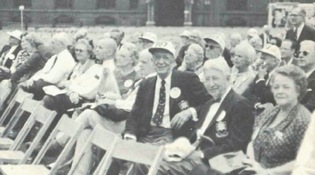 loading
loading
From the EditorA gift from across the yearsFrom one Class of ’17 to another.  Yale Alumni MagazineSome members of the Class of 1917 at their 50th reunion in 1967. View full imageWilliam D. Farnam ’66, as the last child born to the Class of 1917, was given a mission. Knowing that he would likely still be alive in 2017, the class, he explains, “asked me to make sure that there was some kind of ceremony” to mark the one-of-a-kind gift they would bestow this year on both Yale and the Class of 2017. “They knew they wouldn’t be around to see it,” he says. “But they liked the idea that there would be a memory of the class later on.” The idea for the gift is thought to have originated during their 50th reunion. No one now knows quite how it came up. But in his Class Notes of March 1968, 1917 secretary J. Callendar Heminway reminded his classmates to contribute to this “most unique and unusual project.” The plan was to put the money under Yale’s fiscal stewardship and allow it to grow until 2017, when it would be deposited with the Alumni Fund as part of the senior class gift that year. By February 1969, the fund had reached almost $1,900. In May 1977, they calculated that by 2017 it might grow to $20,000. If they had accounted for inflation, that number would have been $80,000. If they had known how Yale’s endowment would grow under David Swensen ’80PhD, they would have come closer to the actual total: more than $660,000. (Yale’s website says the senior classes now typically raise around $25,000.) Amour Alexandre, Class of 2017 and a senior class gift cochair, says in an e-mail, “Their unprecedented generosity is awe-inspiring.” She hopes her class will follow suit in 50 years. How would the Class of 1917 want us to remember them? They were a fun, close-knit group. Farnam knew them well; starting in 1952 or 1957, his father, Henry, took him to every one of their reunions. “When they got together, they were basically a bunch of college kids,” he says. “I used to hear all the bad stories about things they did.” Yes, as freshmen they did throw open their windows and yell “Fire!” when they saw an unaccompanied woman walking across Old Campus. But as grown men “they all knew very well that that was a bad thing to do.” Still, those Farnam knew were, within the confines of their time and upbringing, progressive. “They never really questioned any of the changes” Yale went through in the ’60s and ’70s, he says. While many alumni bitterly excoriated Yale College for admitting women in 1969, Farnam believes many in ’17 “thought that was terrific. They were all for moving on.” They were extremely loyal to Yale; they prided themselves on their Alumni Fund contributions. Heminway and their class fund-raisers enthusiastically prodded ’17 to give, and ’17 enthusiastically set new reunion giving records—again and again. “They had strong principles,” Farnam says. “They believed in supporting the institution.” Most importantly, especially in this centennial year of America’s entering World War I: they were, as one of them wrote, “the war class.” They fought in the Great War, and their sons fought in World War II. Farnam never heard them talk about the war. But in their reunion books, they solemnly honored all those who served—almost everyone in the class—and the 17 who died. There will be a ceremony celebrating the gift on March 30. Yale president Peter Salovey ’86PhD will be there, and representatives of the Class of 2017. If you would like to remember the Class of 1917, raise a glass that day. They would appreciate it.
The comment period has expired.
|
|